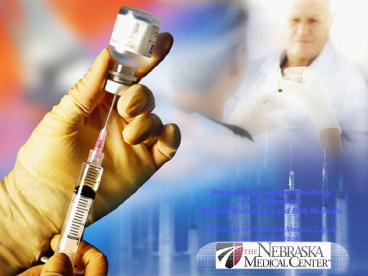Heparin Pathologies - PowerPoint PPT Presentation
1 / 58
Title:
Heparin Pathologies
Description:
Heparin Pathologies. Presented by: Maggie Savelberg, Group Members: Desiree . Bonadonna. and Britt . McIlwain. University of Nebraska Medical Center. Omaha, Nebraska – PowerPoint PPT presentation
Number of Views:205
Avg rating:3.0/5.0
Title: Heparin Pathologies
1
Heparin Pathologies
Presented by Maggie Savelberg, Group
Members Desiree Bonadonna and Britt
McIlwain University of Nebraska Medical
Center Omaha, Nebraska
2
Overview
1
Introduction
2
Coagulation Anticoagulation
3
Heparin
4
Resistance Rebound
5
Allergic Rxns HIT
6
SOP
7
World Knowledge
3
Introduction
- Cardiac surgery requiring cardiopulmonary bypass
(CPB) places a large burden of activation of the
hemostatic coagulation system
Caused by..
Re-infusion of pericardial blood exposed to
thrombogenic surfaces
Blood foreign circuitry interface Blood-air
interface
Effects of microemboli on endothelial cells
Decrease in circulating protein buffers
(Speiss et al., 2008)
4
Introduction
5
Introduction
6
Anticoagulation
Elevated hemostatic activity without
anticoagulation is associated with CPB may induce
a systemic inflammatory reaction and lead to
Therefore, adequate anticoagulation is a critical
component of successful management of hemostatic
and inflammatory responses associated with CPB.
(Parekh, 2008)
7
Coagulation
Understanding current concepts of coagulation is
important in determining the preoperative
bleeding risk of patients and in managing
hemostatic therapy perioperatively. (Tanaka
KA., 2009)
8
Coagulation
9
Anticoagulation
Although the immature systems of neonates needs
further study, according to Gruenwald et al.,
2010 (Sick Kids Hospital Toronto) She can
conclude definitively that individualized heparin
and protamine management in pediatrics has been
shown to reduce platelet activation and
coagulopathies.
10
So how should anticoagulation during CPB be
managed and what other pathologies associated
with heparinization for anticoagulation, be
understood and accounted for?
11
Anticoagulation
1.
2.
3.
(Hirsh, 2001)
12
Heparin
(Hirsh, 2001)
13
Heparin
14
Heparin
15
Heparin
(Hirsh, 2001)
16
Heparin
(Hirsh, 2001)
17
Heparin
Venous thromboembolism Prophylaxis of DVT and
PE Treatment of DVT Coronary heart disease UA
and Acute MI
(Hirsh, 2001)
18
Heparin Dosing
19
Anticoagulation Management
(Lobato, 2010)
20
Anticoagulation Monitoring
21
Anticoagulation Monitoring
22
Anticoagulation Monitoring
(Dunning, 2008)
23
Anticoagulation Monitoring
24
Anticoagulation Monitoring
25
Anticoagulation Management
26
Anticoagulation Management
27
Heparin Resistance
28
Heparin Resistance
Heparin Resistance
(Speiss et al., 2008)
29
Heparin Resistance
Heparin Resistance
(Leong, et al. 1998)
30
Heparin Resistance
Heparin Resistance
(Leong, et al. 1998)
31
Heparin Resistance
Heparin Resistance
(Leong, et al. 1998)
32
Heparin Resistance
Heparin Resistance
SOP Recommendations for AT III dosing are 100
x (weight in kgs) to increase AT III levels from
0 to 100. (Gravlee, 1993)
(Speiss et al., 2008)
33
Heparin Rebound
34
Heparin Rebound
43 of CPB Patients
(Teoh, 2004) (Subramaniam, 2008)
35
Heparin Rebound
Heparin Rebound Effect
(Teoh, 2004)
36
Heparin Rebound
Heparin Rebound
1.
(Teoh , 2004)
37
Heparin Rebound
(Ferraris , 2007)
38
Heparin Allergy
Heparin Rebound
(Subramaniam, 2008)
39
Heparin Rebound
(Subramaniam, 2008)
40
Heparin Allergy
41
Heparin Allergy
Type III Reactions
(Jappe, 2008)
42
Heparin Allergy
(Jappe, 2008)
43
Heparin Allergy
Type I Reactions
44
Heparin Allergy HIT
HIT 1
HIT 2
(1) Cheng, D.., (2006) Perioperative Care in
Cardiac Anesthesia and Surgery. Chp 19 HIT and
Alternatives to Heparin Table taken from pg.174,
(2) (Gurbuz, A.T., et al., 2005) European
Journal of Cardio-thoracic Surgery 27138-149
45
Heparin Allergy HIT 2
Caused by heparin-dependent immunoglobin G (IgG)
antibodies (HIT-IgG) binding to a
conformationally modified epitope on platelet
factor 4 (PF4) antibodies present in 18 of
patients exposed to UFH (Gurbuz, 2004) The
binding of heparin and other glycosaminoglycans
to PF4 heparin-PF4 complex, alters its shape
rendering it immunogenic. Against which IgG
antibodies are formed. (Antigenicity of the
heparin-PF4 complex depends on the molecular
weight and degree of sulfation of the heparin
molecule.)
46
Heparin/PF4 Complex
PF4 Complex
IgG antibody
47
HIT The big picture
48
HIT Diagnosis
- 1. Thrombocytopenia during heparin therapy.
- Note Thrombocytopenia during first 4
post-operative days of cardiac surgery due to
hemodilution and platelet consumption is rarely
HIT related. - 2. Exclusion of other causes of thrombocytopenia
i.e. septicemia, MOF (multi-organ
failure),post-transfusion purpura. - 3. Diagnosis confirmed by
- a) Detection of HIT-IgG antibodies by ELISA, for
heparin-PF4 complexes using goat anti-human
antibody (antigen assay) - b) Or by a heparin-induced platelet aggregation
study (HIPAA) - 4. Resolution of thrombocytopenia after cessation
of heparin.
ELISA Plate
Gurbuz, et al. (2005) Heparin Induced
Thrombocytopenia in the Cardiovascular Patient
Diagnostic and Treatment Guidelines, Eur. J of
Card-Thor Surg. 27138
49
Heparin Allergy
50
World Knowledge
51
World Knowledge
- R.Britt McILwain BS RRT CCP UAB Medical Center
Birmingham, Alabama - Dosing
- Patients lt18 y of age 400 units/kg
- Adults 300 units/kg
- Target ACT Adults (480 s)
- POC testing iStat
- Mgt
- Anesthesia and Perfusion communicate.
- Adults ACTs
- Pediatrics Hepcon (helps account for dilutional
effect with low BSAs) - Brand APP Pharmaceuticals
- Coating Yes, but no change to target ACTs.
- Hemoconcentrate many patients may pull off too
much heparin decreased hep conc.
52
World Knowledge
- Desiree Bonadonna CCP, LP, BSE
- Duke University Hospital
- Durham, NC
- Dosing
- Patients (Avg wt) 30,000 IU
- Smaller and larger 300 IU/kg calculated
- Target ACT Adults (400 s) due to Actalyke
reporting lower but more accurate values
(Welsby, 2002) - POC testing Actalyke ACT analyzer Model A2P by
Helena Laboratories with the MaxACT tube . - Mgt
- Perfusion and anesthesia Re-dose at 20 of
loading dose when ACT low. - Coating Not heparin coated.
53
World Knowledge
54
World Knowledge
Target ACT for CPB Initiation ?
55
World Knowledge
56
World Knowledge
57
World Knowledge
58
Thank you!





















![Prospective evaluation of Innovance D-dimer in the exclusion of venous thromboembolism [VTE]. PowerPoint PPT Presentation](https://s3.amazonaws.com/images.powershow.com/4039270.th0.jpg?_=20130618118)









